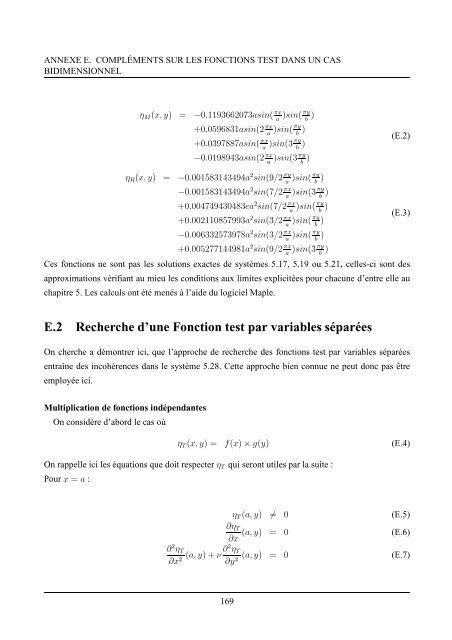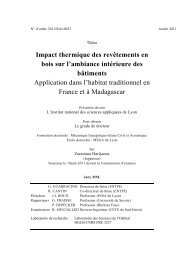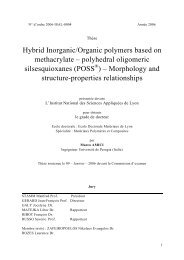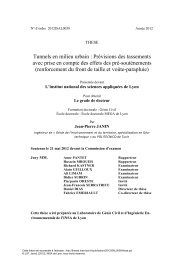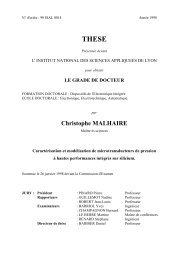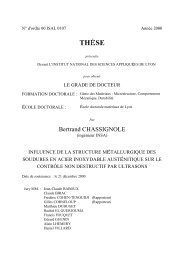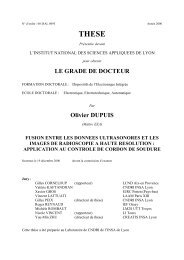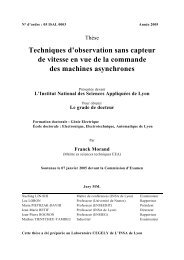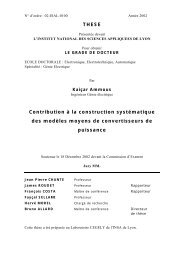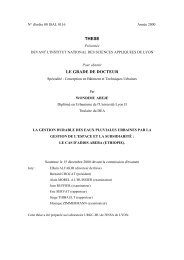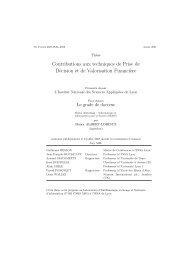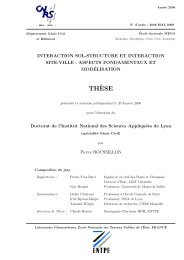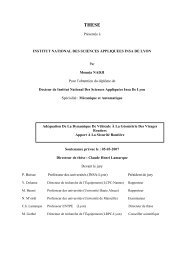Identification d'efforts aux limites des poutres et plaques en flexion ...
Identification d'efforts aux limites des poutres et plaques en flexion ...
Identification d'efforts aux limites des poutres et plaques en flexion ...
You also want an ePaper? Increase the reach of your titles
YUMPU automatically turns print PDFs into web optimized ePapers that Google loves.
ANNEXE E. COMPLÉMENTS SUR LES FONCTIONS TEST DANS UN CAS<br />
BIDIMENSIONNEL<br />
η M (x, y) = −0.1193662073asin( πx<br />
a )sin(πy)<br />
b<br />
+0.0596831asin(2 πx<br />
a )sin(πy)<br />
b<br />
+0.0397887asin( πx<br />
a )sin(3πy)<br />
b<br />
−0.0198943asin(2 πx<br />
a )sin(3πy)<br />
b<br />
η R (x, y) = −0.001583143494a 2 sin(9/2 πy<br />
a )sin(πy)<br />
b<br />
−0.001583143494a 2 sin(7/2 πx<br />
a )sin(3πy)<br />
b<br />
+0.004749430483ea 2 sin(7/2 πx<br />
a )sin(πy)<br />
b<br />
+0.002110857993a 2 sin(3/2 πx<br />
a )sin(πy)<br />
(E.3)<br />
b<br />
−0.006332573978a 2 sin(3/2 πx<br />
a )sin(πy)<br />
b<br />
+0.005277144981a 2 sin(9/2 πx<br />
a )sin(3πy)<br />
b<br />
Ces fonctions ne sont pas les solutions exactes de systèmes 5.17, 5.19 ou 5.21, celles-ci sont <strong>des</strong><br />
(E.2)<br />
approximations vérifiant au mieu les conditions <strong>aux</strong> <strong>limites</strong> explicitées pour chacune d’<strong>en</strong>tre elle au<br />
chapitre 5. Les calculs ont été m<strong>en</strong>és à l’aide du logiciel Maple.<br />
E.2 Recherche d’une Fonction test par variables séparées<br />
On cherche a démontrer ici, que l’approche de recherche <strong>des</strong> fonctions test par variables séparées<br />
<strong>en</strong>traîne <strong>des</strong> incohér<strong>en</strong>ces dans le système 5.28. C<strong>et</strong>te approche bi<strong>en</strong> connue ne peut donc pas être<br />
employée ici.<br />
Multiplication de fonctions indép<strong>en</strong>dantes<br />
On considère d’abord le cas où<br />
η T (x, y) = f(x) × g(y)<br />
(E.4)<br />
On rappelle ici les équations que doit respecter η T qui seront utiles par la suite :<br />
Pour x = a :<br />
η T (a, y) ≠ 0<br />
∂η T<br />
(a, y) = 0<br />
∂x (E.6)<br />
∂ 2 η T<br />
∂x (a, y) + η T<br />
2 ν∂2 (a, y) = 0<br />
∂y (E.7)<br />
2<br />
(E.5)<br />
169


